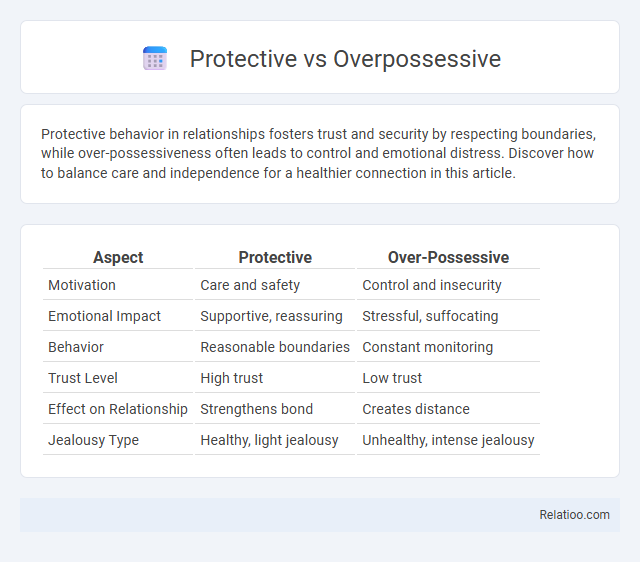Protective behavior in relationships fosters trust and security by respecting boundaries, while over-possessiveness often leads to control and emotional distress. Discover how to balance care and independence for a healthier connection in this article.
Table of Comparison
| Aspect | Protective | Over-Possessive |
|---|---|---|
| Motivation | Care and safety | Control and insecurity |
| Emotional Impact | Supportive, reassuring | Stressful, suffocating |
| Behavior | Reasonable boundaries | Constant monitoring |
| Trust Level | High trust | Low trust |
| Effect on Relationship | Strengthens bond | Creates distance |
| Jealousy Type | Healthy, light jealousy | Unhealthy, intense jealousy |
Understanding Protective vs Over-Possessive Behavior
Protective behavior involves caring and safeguarding loved ones without restricting their freedom or autonomy, whereas over-possessive behavior manifests as excessive control, jealousy, and anxiety over another person's actions or relationships. Over-possessiveness often stems from insecurity and fear of loss, leading to behaviors that can damage trust and intimacy. Understanding these distinctions helps identify when concern shifts into unhealthy control, enabling healthier relationship dynamics.
Key Differences Between Protective and Over-Possessive
Protective behavior involves caring for and ensuring the safety of someone without restricting their freedom, while over-possessiveness reflects an excessive need to control and dominate, often leading to jealousy and insecurity. Your protective instincts are rooted in concern and trust, whereas over-possessiveness stems from fear of loss or lack of confidence. Key differences include respect for boundaries and emotional balance, with protectiveness fostering healthy relationships and over-possessiveness causing tension and conflict.
Healthy Protection: Signs and Benefits
Healthy protection involves setting clear boundaries and providing support without restricting autonomy, fostering trust and emotional security in relationships. Signs include respectful concern for a loved one's well-being, open communication, and encouragement of independence. Benefits of healthy protection encompass stronger emotional bonds, increased self-confidence, and reduced anxiety for both parties.
Over-Possessiveness: Warning Signs and Risks
Over-possessiveness manifests through excessive control, constant monitoring, and intense jealousy over a partner or loved ones, often leading to emotional distress and loss of autonomy for the affected individual. Warning signs include invasive behavior, lack of trust, frequent accusations, and an unwillingness to allow personal space or independence. The risks involve severe relationship strain, increased anxiety, and potential emotional abuse, highlighting the necessity for self-awareness and boundary-setting to maintain healthy interpersonal dynamics.
Psychological Roots of Protective and Over-Possessive Actions
Protective behaviors stem from a desire to ensure safety and well-being, often rooted in secure attachment and past experiences of vulnerability or trauma. Over-possessiveness arises from anxiety, fear of loss, and insecurities, typically linked to low self-esteem or unresolved attachment issues, causing controlling or intrusive actions. Understanding these psychological roots helps you differentiate healthy protection from damaging over-possessiveness in relationships.
Impact on Relationships and Emotional Wellbeing
Protective behavior fosters trust and security in relationships by showing care without restricting freedom, promoting emotional wellbeing for both partners. Over-possessive actions often lead to jealousy, control issues, and a lack of personal space, damaging the emotional health of you and your loved ones. Over-possessiveness intensifies insecurities and can create constant tension, undermining the foundation of healthy connections and emotional stability.
Navigating Boundaries: Balancing Care and Control
Protective behavior involves safeguarding Your loved ones while respecting their autonomy, ensuring trust and safety coexist. Over-possessive actions cross boundaries by exerting excessive control, limiting freedom, and risking emotional harm. Navigating these boundaries requires clear communication and mutual respect to balance care with independence effectively.
Common Misconceptions and Stereotypes
Protective behavior often gets confused with over-possessiveness, creating misconceptions that caring and control are the same. Over-possessiveness involves excessive jealousy and control, harming relationships, while protection is rooted in concern and respect. Your awareness of these differences helps avoid stereotypes that unfairly label protective instincts as controlling or invasive.
How to Address and Resolve Over-Possessiveness
Addressing over-possessiveness requires open communication to establish trust and clarify personal boundaries within relationships. Encouraging individual autonomy while providing reassurance can reduce anxiety that fuels possessive behavior. Professional counseling or therapy can offer valuable strategies to develop healthier attachment patterns and improve emotional regulation.
Building Trust and Healthy Protective Relationships
Protective behavior involves setting boundaries and ensuring safety, fostering trust through consistent and respectful care. Over-possessive actions often stem from insecurity, leading to control and diminished autonomy that undermine healthy relationship dynamics. Building trust requires balancing protective instincts with respect for independence, creating an environment where partners feel secure yet free.

Infographic: Protective vs Over-possessive
 relatioo.com
relatioo.com